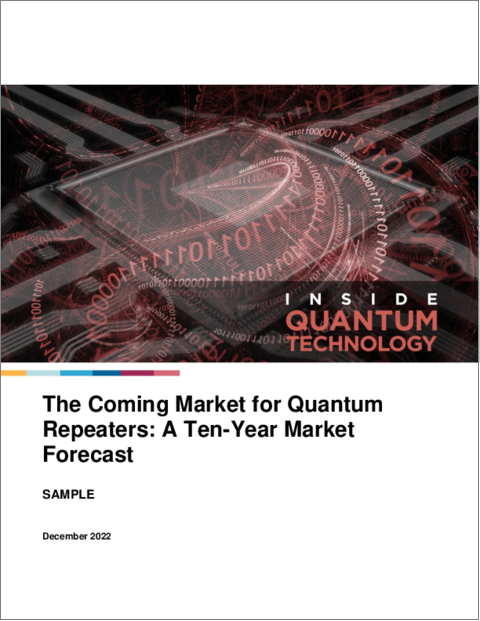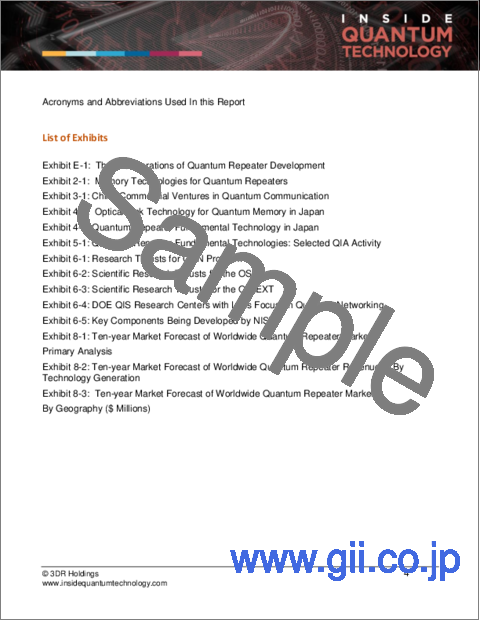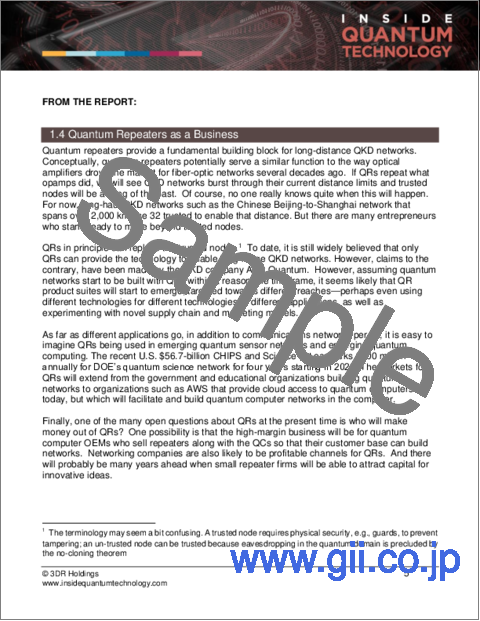|
|
市場調査レポート
商品コード
1152712
量子リピーター市場:10年間の市場予測The Coming Market for Quantum Repeaters: A Ten-Year Market Forecast |
||||||
| 量子リピーター市場:10年間の市場予測 |
|
出版日: 2022年12月31日
発行: Inside Quantum Technology
ページ情報: 英文 51 Pages
納期: 即納可能
|
- 全表示
- 概要
- 目次
当レポートでは、量子リピーター市場について調査分析し、競合の分析や、企業と研究センターの解説などを提供しています。
目次
エグゼクティブサマリー
第1章 イントロダクション
- 本レポートの目的と範囲
- 量子リピーターとは
- 量子リピーターの新技術
- 量子リピーターの設計:量子メモリと光学部品
- 量子リピーター市場:量子ネットワーク、量子インターネット
- エンタングルメントと量子ネットワーキング
- ビジネスとしての量子リピーター
第2章 量子リピーターに求められる新技術
- イントロダクション
- 量子メモリ
- 量子リピーターの同期
- 量子リピーター向けの光子源と検出器
- 量子リピーター向けのエンタングルメントプロトコル
- 量子リピーター向けの誤り訂正
- 見通し
第3章 中国の量子リピーター
- イントロダクション
- Jian Wei-Pan
- Guang-Can Guo
- 中国の量子ネットワーキングの見通し
第4章 アジアの量子リピーター:韓国、日本、シンガポール
- 日本
- 韓国
- シンガポール
第5章 欧州の量子リピーター
- イントロダクション
- オーストリア
- フランス
- スペイン
- スイス
- オランダ
- 英国
第6章 北米の量子リピーター
- イントロダクション
- Center for Quantum Networking
- DOE and DOD Quantum Information Science Centers
- National Institute of Standards - NIST
- Stony Brook University and Brookhaven National Labs
- その他の大学の取り組み
- 民間の研究所:Amazon、Cisco、Juniper
- 米国の量子リピーター開発の見通し
第7章 量子リピーター市場と関連市場への早期参入企業
- イントロダクション
- Aliro Quantum (United States)
- ColdQuanta (United States)
- LQUOM (Japan)
- Quantum Network Technologies (United States)
- Q-bird (The Netherlands)
- Qunnect (United States)
- Raytheon BBN (United States)
第8章 市場の予測
- イントロダクション:予測手法
- 量子リピーターの獲得可能な市場
- 普及率
- 置換率
- プライスポイント
当社について
Several years ago, IQT Research was the first research firm ever to forecast the market for quantum repeaters. We have always believed that the quantum repeater is the enabling technology that will propel the Quantum Internet from a disconnected collection of testbeds to an integrated network capable of carrying qubits. In this new report, IQT Research provides the analysis on what the value of the quantum repeater market will be and who the main contenders are in supplying quantum repeaters at a commercial level.
The introduction of optical amplifiers into the fiber optic networks in the 1980s and 1990s transformed optical networking into a global platform for high-speed data communications and we believe something similar will happen as quantum repeaters are installed in the network. In analyzing who will be the winners and losers in the quantum repeater stakes, we take into consideration vendors' technology and marketing strengths as well their connections to the marketplace. This report also describes at a granular level the various approaches to building quantum repeaters and tier one companies and research centers developing them.
Repeaters provide the ability to build distributed quantum networks connecting quantum devices such as quantum sensors and quantum computers and therefore potentially quantum repeaters create huge amounts of value for carriers, equipment vendors and component makers. But many challenges remain as do big differences of opinion on how quantum repeaters can be built most profitably. This report will provide a "guide for the perplexed" on where the money will be made and where it will be lost in the quantum repeater market to come.
Table of Contents
Executive Summary
- E.1. Goal and Scope of this Report
- E.2. Quantum Memories and Quantum Repeaters
- E.3. Markets for Quantum Repeaters
Chapter One: Introduction
- 1.1. Goal and Scope of this Report
- 1.2. What is a Quantum Repeater?
- 1.2.1. New Technologies for Quantum Repeaters
- 1.2.2. Quantum Repeater Designs: Quantum Memories and Optical Components
- 1.3. Markets for Quantum Repeaters: Quantum Networks the Quantum Internet
- 1.3.1. Entanglement and Quantum Networking
- 1.4. Quantum Repeaters as a Business
Chapter Two: New Technologies Required for Quantum Repeaters
- 2.1. Introduction
- 2.1.1. First-generation Repeaters
- 2.1.2. Materials for Repeaters
- 2.2. Quantum Memory
- 2.3. Synchronization for Quantum Repeaters
- 2.4. Photon Sources and Detectors for Quantum Repeaters
- 2.5. Entanglement Protocols for Quantum Repeaters
- 2.6. Error Correction for Quantum Repeaters
- 2.7. Outlook
Chapter Three: Quantum Repeaters in China
- 3.1. Introduction
- 3.2. Jian Wei-Pan
- 3.2.1. All-Optical Approach to QRs
- 3.2.2. Cold Atoms
- 3.3. Guang-Can Guo
- 3.4. Outlook for China's Quantum Networking
Chapter Four: Quantum Repeaters in Asia: South Korea, Japan and Singapore
- 4.1. Japan
- 4.1.1. QuREP
- 4.1.2. NTT
- 4.1.3. Toshiba
- 4.2. South Korea
- 4.3. Singapore
Chapter Five: Quantum Repeaters in Europe
- 5.1. Introduction
- 5.1.1. Outlook for European QR Development
- 5.2. Austria
- 5.2.1. The Invention of GHZ
- 5.2.2. Quantum Austria Funding Initiative
- 5.3. France
- 5.3.1. French Quantum Plan
- 5.3.2. CNRS and PASQAL
- 5.3.3. CEA
- 5.3.4. INRIA
- 5.4. Spain
- 5.4.1. Institute of Photonic Sciences (ICFO)
- 5.4.2. Barcelona Institute of Science and Technology
- 5.5. Switzerland
- 5.5.1. University of Geneva
- 5.5.2. EPFL
- 5.5.3. ETH-Zurich
- 5.5.4. IDQuantique
- 5.6. The Netherlands
- 5.6.1. QIA
- 5.7. United Kingdom
- 5.7.1. The Networked Quantum Information Technologies NQIT Hub
- 5.7.2. Advances in Quantum Memories
Chapter Six: Quantum Repeaters in North America
- 6.1. Introduction
- 6.1.1. National Quantum Initiative
- 6.1.2. National Subcommittee on Quantum Information Science
- 6.1.3. CHIPS
- 6.2. Center for Quantum Networking
- 6.3. DOE and DOD Quantum Information Science Centers
- 6.3.1. The Quantum Science Center
- 6.3.2. Q-NEXT Science Center
- 6.3.3. Other DOD-led Research Centers
- 6.4. National Institute of Standards - NIST
- 6.5. Stony Brook University and Brookhaven National Labs
- 6.6. Other University Efforts
- 6.7. Commercial Labs: Amazon, Cisco and Juniper
- 6.7.1. Cisco Systems
- 6.7.2. Juniper
- 6.7.3. Amazon
- 6.8. Outlook for Quantum Repeater Development in the U.S.
Chapter Seven: Early Entrants into the Quantum Repeater and Related Markets
- 7.1. Introduction
- 7.2. Aliro Quantum (United States)
- 7.2.1. Emulators and Simulators
- 7.2.2. Outlook
- 7.3. ColdQuanta (United States)
- 7.3.1. Outlook
- 7.4. LQUOM (Japan)
- 7.4.1. Products
- 7.5. Quantum Network Technologies (United States)
- 7.6. Q-bird (The Netherlands)
- 7.7. Qunnect (United States)
- 7.7.1. Qunnect Hardware
- 7.7.2. Finance
- 7.8. Raytheon BBN (United States)
Chapter Eight: Market Forecast
- 8.1. Introduction: Forecasting Methodology
- 8.2. Available Market for Quantum Repeaters
- 8.3. Penetration Rates
- 8.4. Replacement Rates
- 8.5. Price Points
About IQT Research
- About the Analyst
- Acronyms and Abbreviations Used In this Report
List of Exhibits
- Exhibit E-1: Three Generations of Quantum Repeater Development
- Exhibit 2-1: Memory Technologies for Quantum Repeaters
- Exhibit 3-1: China Commercial Ventures in Quantum Communication
- Exhibit 4-1: Optical Link Technology for Quantum Memory in Japan
- Exhibit 4-2: Quantum Repeater Fundamental Technology in Japan
- Exhibit 5-1: Quantum Repeater Fundamental Technologies: Selected QIA Activity
- Exhibit 6-1: Research Thrusts for CQN Program
- Exhibit 6-2: Scientific Research Thrusts for the OSC
- Exhibit 6-3: Scientific Research Thrusts for the Q-NEXT
- Exhibit 6-4: DOE QIS Research Centers with Less Focus on Quantum Networking
- Exhibit 6-5: Key Components Being Developed by NIST
- Exhibit 8-1: Ten-year Market Forecast of Worldwide Quantum Repeater Market: Primary Analysis
- Exhibit 8-2: Ten-year Market Forecast of Worldwide Quantum Repeater Revenues: By Technology Generation ($ Millions)
- Exhibit 8-3: Ten-year Market Forecast of Worldwide Quantum Repeater Market: By Geography ($ Millions)




